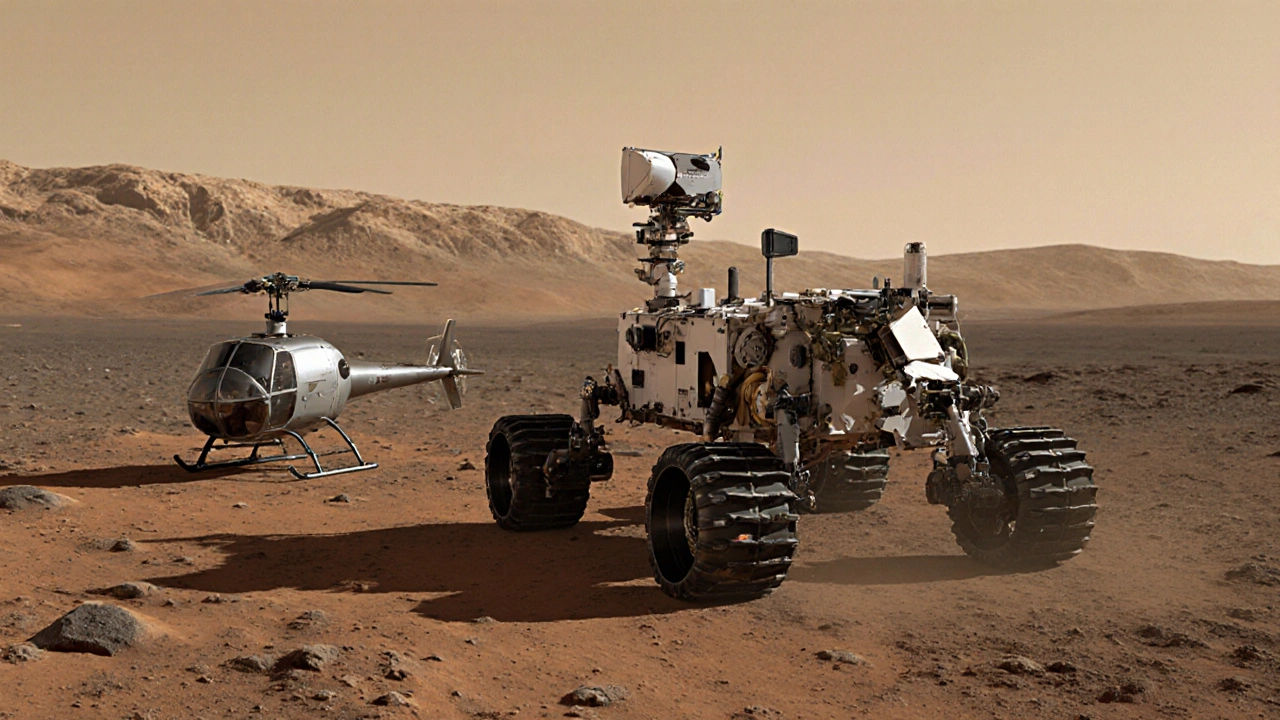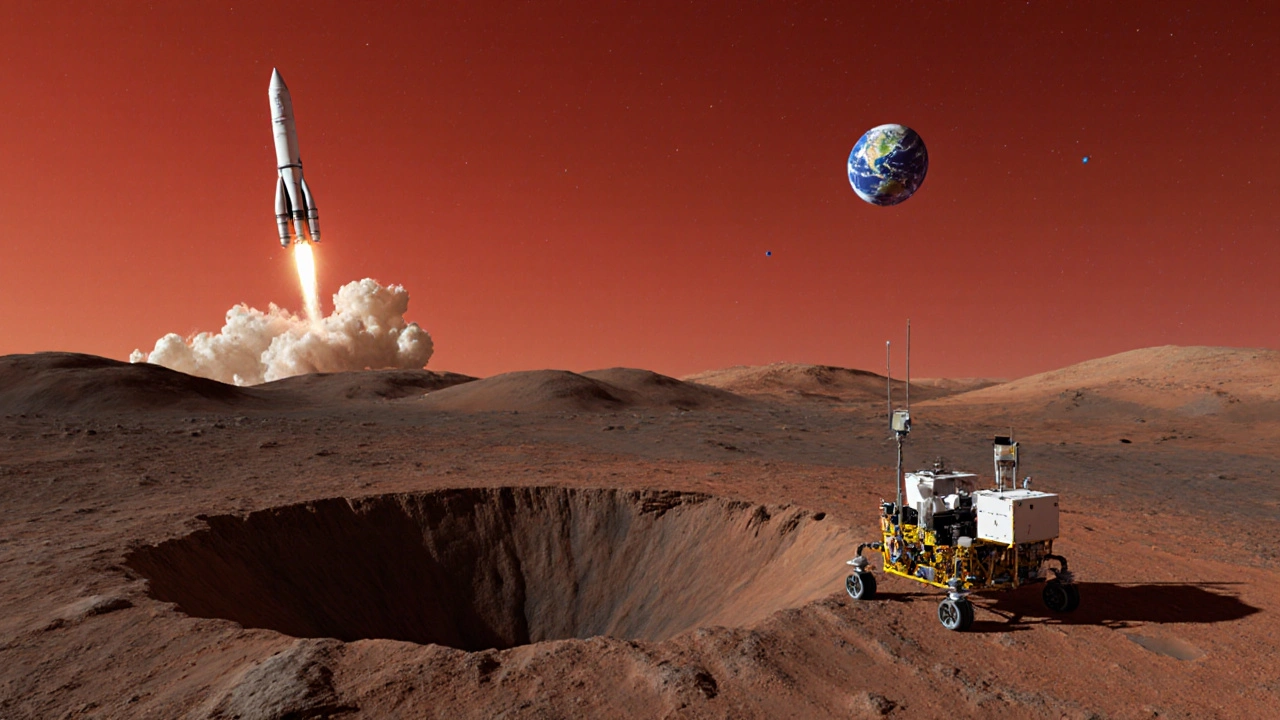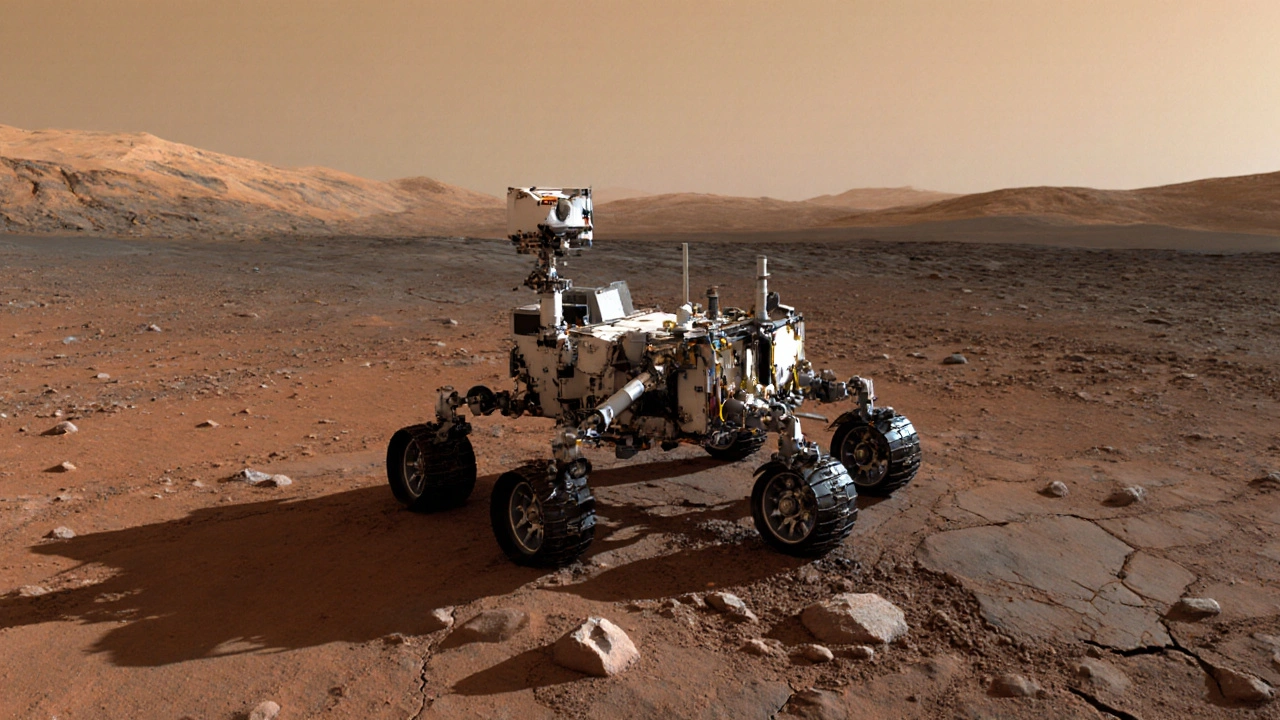Curiosity and Perseverance: Two Rovers, One Mission
When you think of Mars rovers, you probably picture those six-wheeled robots crawling across red dust, snapping photos, and sending back data from another world. But the story of NASA’s two most recent rovers-Curiosity and Perseverance-isn’t just about machines on Mars. It’s about how we learned to build better tools by watching what worked, what broke, and what needed to change.
Curiosity landed in Gale Crater in August 2012 with one clear goal: find out if Mars ever had the right conditions for life. It didn’t just answer that question-it proved it. By drilling into ancient lakebed rocks, Curiosity found organic molecules, clay minerals, and chemical signs of freshwater that could have supported microbes billions of years ago. That discovery alone changed everything we thought we knew about Mars.
Perseverance didn’t come to repeat that job. It came to build on it.
Same Bones, New Brain
At first glance, Perseverance looks like Curiosity’s twin. Same body shape. Same nuclear battery. Same six wheels. But look closer, and you’ll see the differences.
Perseverance is heavier-1,025 kilograms compared to Curiosity’s 899. That extra weight isn’t just for show. It’s packed with better tools. Its chassis is 12 centimeters longer to fit new instruments. The wheels? Totally redesigned. After Curiosity got stuck in sand in 2014 and its wheels started tearing, engineers went back to the drawing board. Perseverance’s wheels are thicker, have straighter treads, and twice as many tread segments. They’re built to last longer and handle rougher terrain.
Perseverance’s "brain" is smarter too. It can analyze images and plan its own path up to five times faster than Curiosity. That means less waiting for commands from Earth. On Mars, a single message takes 4 to 24 minutes to reach us. If you have to wait for every turn, you waste hours. Perseverance doesn’t. It drives itself.
The Camera Revolution
Curiosity had 17 cameras. Perseverance has 23. That’s not just more pictures-it’s a whole new way of seeing Mars.
Most of Perseverance’s cameras capture color. That matters. Color helps scientists spot mineral differences, weather patterns, and even dust movement. One camera, mounted on the rover’s mast, even records high-definition video of the rover’s descent and landing. You’ve probably seen those clips-dust swirling, the sky turning orange, the parachute snapping open. That’s not just cool footage. It’s engineering gold.
Perseverance also carries a microphone. Not just one, but two. You can actually hear the Martian wind. You can hear the laser zapping rocks. That’s new. Sound gives scientists another layer of data. It tells them how dense the air is, how hard a rock is, even how far away something is.
The Sample Cache: A First in Space History
This is where Perseverance breaks away completely. Curiosity drilled rocks and analyzed them on-site. Perseverance drills, seals, and stores them-for Earth.
Its robotic arm carries a coring drill that pulls out rock cores 13 millimeters wide and up to 60 millimeters long. Each core goes into a sterile titanium tube. Those tubes are sealed, labeled, and left on the surface of Mars. Later, another mission will come, pick them up, and bring them home.
It’s the most complex mechanism ever sent to another planet. Over 3,000 parts. One mistake, one contamination, and the whole mission could be ruined. That’s why NASA spent over a decade testing this system on Earth. No one had ever tried to collect samples on Mars and leave them for someone else to find. It’s like sending a letter to the future and hoping it gets delivered.

Ingenuity: The Little Helicopter That Could
Perseverance didn’t just bring tools. It brought a friend.
Attached to its belly was Ingenuity, a tiny helicopter no bigger than a tissue box. NASA planned for it to fly five times. It flew 72.
Ingenuity proved that powered flight is possible on Mars-where the air is just 1% as thick as Earth’s. It scouted paths for Perseverance, found safe routes around cliffs, and even spotted rocks scientists hadn’t noticed from the ground. It didn’t carry science instruments. It carried hope. And it worked better than anyone dared imagine.
MOXIE: Making Oxygen on Mars
Perseverance carries something no other rover ever has: a machine that turns Martian air into oxygen.
Called MOXIE, it pulls in carbon dioxide from the atmosphere, splits it apart, and releases oxygen. In April 2021, it made its first 5.4 grams of oxygen-enough for a human to breathe for about 10 minutes. By December 2023, it had produced 122 grams total.
That’s not much. But it’s proof. If we ever send astronauts to Mars, they’ll need oxygen-not just to breathe, but to burn rocket fuel. Carrying it all from Earth is impossible. Making it on Mars? That’s the key.
Why Curiosity Still Matters
Some people think Perseverance made Curiosity obsolete. It didn’t.
Curiosity has been running for over 3,800 Martian days-more than five times longer than its planned mission. It’s still sending data. It’s still moving. It’s watched seasons change on Mars. It’s tracked how radiation levels shift. It’s studied dust storms from the inside out.
Perseverance moves faster and sees more. But Curiosity taught us how to survive. How to adapt. How to keep going when the wheels start to crack and the software glitches. Perseverance stands on Curiosity’s shoulders. Without it, Perseverance wouldn’t exist.

The Big Picture: What Comes Next
The next step? Bringing those samples home.
NASA and the European Space Agency are planning the Mars Sample Return mission. A lander will go to Mars around 2028, pick up the tubes Perseverance left behind, load them into a rocket, and launch them into orbit. Another spacecraft will catch them and bring them back to Earth by 2033.
It’s ambitious. It’s expensive-estimated at over $4 billion. But it’s worth it. These rocks could answer the biggest question: Did life ever exist on Mars?
Back on Earth, scientists will use machines far more powerful than anything on Mars. They’ll look for signs of ancient microbes, study chemical traces, and compare the samples to Earth rocks. That’s the real goal-not just to explore Mars, but to understand how life begins.
Challenges and Criticisms
It hasn’t been smooth sailing.
Perseverance moved slower than Curiosity in its first year. In 367 sols, it covered just 1.9 kilometers. Curiosity did 7.9 in the same time. Why? Because Perseverance’s team was being extra careful. They were testing new systems, watching for dust, avoiding hazards. They weren’t racing. They were learning.
Some scientists worry about the cost. The sample return mission could eat up NASA’s planetary science budget for years. Others worry about contamination-what if we bring back something dangerous? NASA has protocols for that. Quarantine labs. Biocontainment. It’s all planned.
Still, the public loves it. Reddit threads about Perseverance’s photos get thousands of upvotes. NASA’s public data portal had 14.7 million visitors in 2022. People aren’t just watching. They’re feeling part of it.
What These Rovers Mean for Us
Curiosity and Perseverance aren’t just robots. They’re extensions of us. They go where we can’t. They feel what we can’t. They answer questions we’ve asked for centuries.
They show us that exploration isn’t about speed. It’s about patience. About learning from failure. About building something that lasts.
When we finally hold a rock from Mars in our hands, we won’t just see geology. We’ll see the work of thousands of engineers, scientists, and technicians. We’ll see the legacy of a rover that drove for over a decade. And we’ll see the quiet, determined robot that dared to fly.
What’s the main difference between Curiosity and Perseverance?
Curiosity was built to find out if Mars ever had conditions that could support life. It did that by discovering ancient lakes and organic molecules. Perseverance was built to find direct signs of past microbial life and collect rock samples to bring back to Earth. It’s not just studying Mars-it’s preparing to bring pieces of it home.
Why did Perseverance’s wheels look different from Curiosity’s?
Curiosity’s wheels started tearing after getting stuck in sand in 2014. Engineers redesigned Perseverance’s wheels to be thicker, narrower, and with more tread segments-48 instead of 24. They also changed the tread pattern from chevron to straight lines for better durability. These changes help Perseverance handle rougher terrain without damage.
How does Perseverance navigate Mars better than Curiosity?
Perseverance’s autonomous navigation system processes images and plans paths up to five times faster than Curiosity’s. This lets it drive up to 200 meters per Martian day on its own, without waiting for commands from Earth. Curiosity usually needed daily instructions, which slowed progress. Perseverance’s speed comes from smarter software and better cameras.
What is MOXIE, and why is it important?
MOXIE is a device on Perseverance that turns carbon dioxide from Mars’ atmosphere into oxygen. It’s a test for future human missions. Astronauts will need oxygen to breathe and to burn rocket fuel. Carrying it all from Earth isn’t practical. MOXIE proved we can make oxygen on Mars-which could make human exploration possible.
Why is the Mars Sample Return mission so important?
The samples Perseverance collected could contain signs of ancient microbial life. Earth labs have tools far more powerful than anything on Mars. Scientists can analyze these rocks in detail-looking for chemical traces, fossil structures, or biological signatures-that rovers can’t detect. Bringing them home is the only way to answer the question: Did life ever exist on Mars?
Is Perseverance still active?
Yes. As of late 2023, Perseverance is still exploring Jezero Crater, collecting more rock samples and testing new technologies. It’s also continuing its work with the Ingenuity helicopter, which completed its final flight in January 2024 after 72 successful missions. Both rovers are exceeding their planned lifespans and continue to send back valuable data.


2 Responses
I still get chills watching the landing footage. That parachute deploying in thin Martian air? Pure magic. And the fact that we can now hear the wind? Mind blown. This isn't just science-it’s poetry written in dust and metal.
i always thought rovers were just fancy cars with cameras but learning how pereseverance plans its own path... wow. we’re basically giving machines intuition now. kinda beautiful in a scary way.